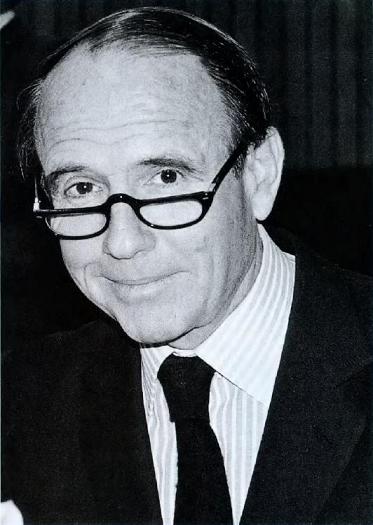
Prince Sadruddin Aga Khan (1933 – 2003). Photo: UNESCO Courier. Copyright
Profile: Born in Paris, France, the late Prince Sadruddin Aga Khan, KBE (17 January 1933 – 12 May 2003) was the son of Sir Sultan Muhammad Shah, His Highness the Aga Khan III, 48th Imam of the Shia Nizari Ismailis. Prince Sadruddin studied at Harvard where he came to abhor racial injustice, and joined the National Association for the Advancement of Coloured People.
 While still at Harvard in 1953, Prince Sadruddin became the founding publisher of the Paris Review, which was established with the aim of bringing original creative work to the fore. Every year the Review awards the Aga Khan Prize for Fiction (established by his father) for the best short story that it published in the past year.
While still at Harvard in 1953, Prince Sadruddin became the founding publisher of the Paris Review, which was established with the aim of bringing original creative work to the fore. Every year the Review awards the Aga Khan Prize for Fiction (established by his father) for the best short story that it published in the past year.
After graduating from Harvard, Prince Sadruddin was recruited by UNESCO in 1958, and embarked on a brilliant international career. He helped raise funds for UNESCO for the preservation of the great Nubian monuments, such as Abu Simbel, which were threatened by the building of the Aswan Dam. In 1962, barely 29, he became Deputy High Commissioner for Refugees with the United Nations, and in 1965 he became United Nations High Commissioner for Refugees, a position he held until 1977. As High Commissioner, he reoriented the agency’s focus beyond Europe (see interview below) and prepared it for an explosion of complex refugee issues. He was also a proponent of greater collaboration between non-governmental organizations (NGOs) and UN agencies. In 1981, he won the vote to become the U.N. Secretary-General, but his election was vetoed by the Soviet Union. He remained in the field of humanitarian action all his life for which he was decorated and recognized by the United Nations, the Vatican and the countries of Sudan, Iran, Afghanistan, Poland and France.

His Highness the Aga Khan, nephew of the late Prince Sadruddin, speaks at the luncheon marking the merger of the Bellerive Foundation and the Aga Khan Foundation as Princess Catherine looks on. Photo: AKDN.org
Prince Sadruddin’s interest in ecological issues led him to create the Bellerive Foundation, Geneva, which promoted the conservation of the earth’s natural resources and protection of all life forms and the environment. In developing countries, the foundation encouraged tree conservation and tree-planting activities, reduction of fuelwood consumption through dissemination of fuel-saving domestic and institutional cooking systems, and education on tree and fuelwood conservation through children’s programs and women’s groups. In recognition of this, Prince Sadruddin Aga Khan received the World Ecology Medal from the International Center for Tropical Ecology of the University of Missouri-St. Louis at a ceremony in April 1993 in Washington D.C.
After his death, the Bellerive merged with the Aga Khan Foundation to form The Prince Sadruddin Aga Khan Fund for the Environment. Although not existing in name anymore, the legacy of Bellerive Foundation will live on through the activities of the Prince Sadruddin Aga Khan Fund where Prince Hussain Aga Khan, younger son of Prince Karim Aga Khan, assumed the responsibility for the conceptualisation of programmes on environmental issues. Indeed, Prince Hussain’s interests on ecological issues and animal photography, was inspired by the work of his paternal uncle, Prince Sadruddin, who also held the position of the vice-president of the World Wide Fund for Nature.
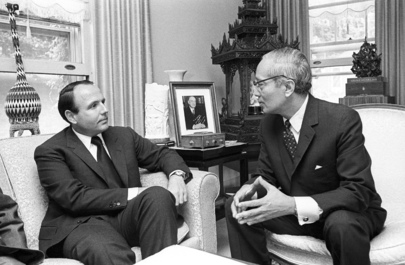 The United Nations High Commissioner for Refugees (UNHCR), Sadruddin Aga Khan, completed a 12-day visit to Pakistan and India on 18 June, 1971. He flew to New York on 22 June to consult with the Secretary-General on plans for assisting refugees from East Pakistan. Prince Sadruddin Aga Khan is seen as he called upon Secretary-General U Thant at his home on 23 June 1971. Photo Credit: UN Photo |
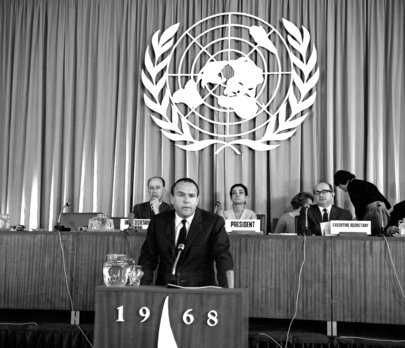 International Conference on Human Rights Opened in Teheran, 22 April – 13 May 1968. The Conference, called by the General Assembly, served as a major event in the International Year for Human Rights, 1968, which was proclaimed by the Assembly to commemorate the twentieth anniversary of the adoption of the Universal Declaration of Human Rights. Prince Sadruddin Aga Khan, UN High Commissioner for Refugees, seen making a statement at the plenary meeting held on 25 April. Photo Credit: UN Photo |
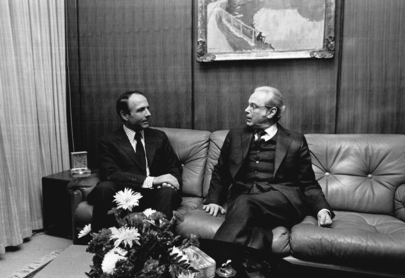 Javier Perez de Cuellar, former Secretary-General of the United Nations, in a meeting with Prince Sadruddin Aga Khan, former United Nations High Commissioner for Refugees, to discuss his report which had been considered by the Commission on Human Rights in Geneva, and was then referred to the thirty-seventh General Assembly session. Photo Credit: UN Photo |
During his lifetime Prince Sadruddin assembled one of the finest private collections of Islamic art in the world. He became a knowledgeable and respected collector, accumulating a priceless collection of paintings, drawings, manuscripts and miniatures over 50 years. Over the years, parts of his collection were exhibited in New York, London, and Zurich, including a touring show, “Princes, Poets and Paladins”, which was organized by the British Museum in 1998. The full collection will soon be housed at the new Aga Khan museum being established by Prince Sadruddin’s nephew, the present Aga Khan, in Toronto.

The front cover of British Museum’s catalogue of the exhibition “Islamic and Indian Paintings from the Collection of Prince and Princess Sadruddin Aga Khan”
Prince Sadruddin died at the age of 70, and was buried in Switzerland. The United Nations community celebrated Prince Sadruddin’s life at a memorial ceremony held in his honour at its headquarters in New York on 28 October 2003. He was remembered for representing the moral and compassionate side of the international community. Then United Nations Secretary-General Kofi Annan commented that “he combined respect for humankind with concern for our environment. He worked on behalf of the poor and dispossessed, while celebrating humanity through culture and art.” He concluded his tribute by praising Prince Sadruddin as “a role model to many of us … his example will continue to inspire new world citizens for several generations to come.”
Prince Sadruddin is survived by his wife of 31 years, Princess Catherine; his three stepsons Alexandre, Marc and Nicholas; as well as his nephews and niece Prince Karim, Prince Amyn and Princess Yasmin; and his cousin Mme. Francoise Carron. It was Prince Sadruddin’s and Princess Catherine’s wish that their mortal remains ultimately be laid to rest in Muslim soil in Egypt.

1950′s. His Highness the Aga Khan III, 48th Ismaili Imam, with his grand daughter, Princess Yasmin and, standing from left to right, grandson Prince Amyn Muhammad, his two sons the late Prince Sadruddin and Prince Aly Khan holding daughter, and second grandson Prince Karim, the 49th and present Imam. Photo: Zul Khoja Collection, Ottawa.
Profile compiled by Simerg from following sources:
(1) Whitney R. Harris World Ecology Center, University of Missouri (St. Louis)
(2) The Aga Khan Development Network
(3) The Wilson Center, Washington D.C.
(4) Wikipedia
The following interview first appeared in The UNESCO Courier in May 1991.
________________
INTERVIEW WITH
SADRUDDIN AGA KHAN

The front cover of UNESCO Courier magazine which contains this rare and insightful interview with Prince Sadruddin Aga Khan. The issue is dated May 1991.
At that time [Cold War] refugees were pictured as people who crossed the Iron Curtain and were fired on from frontier watchtowers. But where did this leave the African populations who were victims of general instability, fleeing tribal warfare on both sides of frontiers traced arbitrarily by the colonial powers?….
Very early on, and perhaps this is the best thing I have done in my career, I tried to avoid all discrimination between European and Third World refugees.
Courier: You have been associated with the United Nations system for many years. Did you feel a vocation to serve the UN?
Prince Sadruddin: I think people are primarily influenced by their family environment. Because of my origins I belong both to the East and the West. Iran is the cradle of our family, but we have never lived there. I was born in Paris, and my mother was French. Through my father, who had a strong influence on me, I came into contact with Islam when I was very young. We travelled widely in the Islamic countries and often visited Egypt. My father was a pioneer in international organizations: he played an active part in the creation of the League of Nations, was its president in 1937, and even inaugurated the Palais des Nations in Geneva. My office is only a few steps away from the one he occupied. That makes for a kind of continuity.
Courier: As well as being a senior international civil servant, you are also known as a man of ideas and someone who is closely involved in grassroots issues.
Prince Sadruddin: I have tried to resist the forces of bureaucratic inertia. In the corridors of diplomacy people gradually tend to lose their capacity to distinguish between what is important and what isn’t. A phrase or a comma in a draft resolution suddenly come to assume disproportionate importance. Negotiations go on for hours, for nights on end, before agreement is reached on what is generally the lowest common denominator. You feel that you have won a great victory. But no-one will read the text which was so difficult to draft.
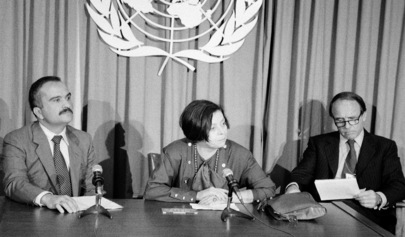
Jordan’s Crown Prince Hassan ibn Talal (left) and Prince Sadruddin Aga Khan, Chairman and co-Chairman respectively of the Independent Commission on International Humanitarian Issues, hold a press conference on the Commission’s work, accompanied by Therese Paquet-Sevigny, Under-Secretary-General for Public Information. Prince Hassan said that the need now was not for new ideas but for ways to implement existing recommendations. Photo Credit: UN Photo/John Isaac
Courier: Don’t you find this sort of thing futile?
Prince Sadruddin: History will judge. Perhaps we shall have a more objective perspective on the United Nations when we come to celebrate its fiftieth anniversary. Certainly it is a good thing not to always observe the world through United Nations spectacles. That’s why I have set so much store by my independence.
Courier: While waiting for the judgement of history, don’t you see positive aspects in the work of the United Nations?
Prince Sadruddin: Indeed. It is now widely and rightly accepted that we live in a world which is more interdependent than ever before, and that problems are increasingly global in character. At the risk of stating the obvious, I would say that when governments realize that certain problems are beyond their powers, it is clear that the United Nations has an irreplaceable role to play. At the same time, the world is changing considerably and the United Nations must change too. It must become an instrument which responds to the needs of the international community of the year 2000, which will be quite different from that of 1945. This is very far from the case. We should not delude ourselves into thinking that the United Nations is going to change because a certain role has been restored to the Security Council. The Security Council is an exclusive club with a restricted membership, sensitive to the moods of the moment. Its resolutions only remotely affect the organs and institutions of the United Nations which face the great challenges of today.
Courier: To return to your own career, which has always taken you towards the most practical activities of international life. I believe you started by taking an interest in the problem of the Abu Simbel temples.
Prince Sadruddin: Yes, I took my first steps in international life at UNESCO, which at that time was conducting an exciting campaign to save the monuments of Nubia, a campaign which in my opinion remains one of UNESCO’s great achievements. In the middle of the Cold War it was quite remarkable to get East European archaeologists to join archaeologists from the United States and other Western countries in order to save the treasures of ancient Egypt. Not to mention that since 1956 Nasser had not exactly been the most popular Arab figure in the West.

The Nubian Monuments are in an archaeological zone of primary importance which extends from Aswan to the Sudanese border. It includes magnificent monuments as the Temples of Ramses II at Abu Simbel and the Sanctuary of Isis at Philae, which were saved from the rising waters of the Nile thanks to the International Campaign launched by UNESCO, in 1960 to 1980. Photo Credit: UNESCO
Courier: Did the general feeling that Abu Simbel should be saved crystallize at a precise moment?
Prince Sadruddin: Not only Abu Simbel. There were other monuments which were just as important: the temples of Philae and Kalabsha, the Christian churches of Nubia. The Upper Egypt of the great pharaonic civilizations did not stop at Aswan, it extended to Nubia, to Khartoum in the Sudan. In order to develop, all these regions needed the resources that tourism could bring them.
From an entirely different point of view, in face of the threat of the flooding of archaeological sites by the construction of the Aswan dam, all kinds of people from many countries, independently of their political orientations, were united in thinking that something should be done. At that time, I was executive secretary of UNESCO’s international action committee for the preservation of the Nubian sites and monuments, and I was strongly aware of this feeling.
Courier: So this was your first mission?
Prince Sadruddin: I was also Head of Mission and Advisor to the United Nations High Commissioner for Refugees (UNHCR). I was principally concerned with World Refugee Year (1959-1960). Through a philatelic programme to which all member states of the UN and the Universal Postal Union contributed, we collected a large sum of money and also gave pleasure to stamp collectors.

A Poster of the United High Commission of Refugees. Prince Sadruddin was the agency’s longest serving High Commissioner. Photo Credit: UNESCO Courier
Courier: Was this for the benefit of European refugees alone?
Prince Sadruddin: No. World Refugee Year was very useful for the Palestine refugees, since the United Nations Relief and Works Agency (UNRWA), which was responsible for providing them with assistance, had been in existence since 1949. But it is true that around this time refugees began to appear in the Third World who did not benefit from United Nations aid. One such case was that of the Vietnamese who had fled from the north of their country after the battle of Dien Bien Phu. In Africa, the first refugees from Angola were entering Congo-Kinshasa and Congo-Brazzaville. Refugees from Algeria were flowing into Morocco and Tunisia. These were new situations for UNHCR, which had been originally created for refugees from Eastern Europe and was a kind of European club. Very early on, and perhaps this is the best thing I have done in my career, I tried to avoid all discrimination between European and Third World refugees.

UN High Commissioner for Refugees, Sadruddin Aga Khan, and Abel Alier, President of the Provisional High Executive council of the South Sudan visit the village of Kajo Kaji, South Sudan. Photo Credit: UN Photo/1972
Courier: Why were there different categories of refugees and what form did these differences take?
Prince Sadruddin: They were the result of constraints that were essentially legal. United Nations action was subject to the 1951 UN Convention relating to the Status of Refugees, an international instrument which was drawn up during the Cold War and, as everyone now accepts, made UNHCR a propaganda instrument against the Eastern countries.
In order to benefit from UNHCR protection, a refugee had to be able to prove that he or she was persecuted for reasons of race, religion, nationality or political opinions, was outside his or her country of origin, and could not enjoy that country’s protection. At that time refugees were pictured as people who crossed the Iron Curtain and were fired on from frontier watchtowers. But where did this leave the African populations who were victims of general instability, fleeing tribal warfare on both sides of frontiers traced arbitrarily by the colonial powers? In Hungary in 1956 and Czechoslovakia in 1968 people knew where the frontiers with Austria were. But there was not a single frontier post between Angola and what was then Congo-Kinshasa!
It was necessary to widen the UNHCR mandate, and this was a long and legally complex process. The protection of the High Commissioner was finally extended to new categories of refugees by virtue of a Protocol which was adopted in 1967 and which I myself strongly supported. These same refugees were also able to benefit from the so-called “good offices” resolutions voted by the General Assembly of the United Nations.
Courier: It looks as if Third World refugees were a frightening prospect at that time…
Prince Sadruddin: People saw millions of men, women and children who could not be integrated. They feared the economic and financial consequences and the repercussions on the labour market. It was already a North-South problem. If it was easy to resettle Czechs, Russians or Hungarians in countries like Australia, New Zealand, the United States and even South Africa, it was difficult to integrate in those countries displaced people originating from Africa or Asia. In any case, most of these refugees did not wish to be resettled permanently. They looked forward to the day when they could return home.

Refugees on the border of Cambodia and Thailand. Photo Credit: The UNESCO Courier
Courier: In the twelve years you spent as UN High Commissionerfor Refugees, did you see any major changes in the situation of refugees worldwide?
Prince Sadruddin: Yes. First of all, the problem of European refugees was virtually solved, except for certain specific cases such as Polish emigration to the Scandinavian countries or the case of the Baltic countries today. In the Third World, on the other hand, we had to face massive exoduses. In the 1950s in Europe, there were between 200,000 and 300,000 refugees to be helped. In 1971, in Bangladesh alone, there were 10 million overnight! And they were not the only ones. Hundreds of thousands of refugees from the Sudan, Mozambique, Angola, Guinea-Bissau and Viet Nam, were waiting to go home.
At present, my successors at the head of UNHCR are faced with another problem: that of the refugees who quit their country and find themselves in camps which they cannot leave on the borders of Cambodia and Thailand, in Hong Kong or El Salvador. They can neither return to their own countries nor go to another. They cannot be integrated, for political, economic or ethnic reasons, either because they do not want to stay in the host country or because the latter refuses to have them. It is a terrible problem.
There is also a new category of refugees which I will call “ecological” refugees. They leave regions in which they can no longer survive, because the food resources are exhausted, the desert is advancing inexorably, and they can no longer even find enough firewood to cook their food. And so they leave. They are not stopped by frontiers. In many cases they cannot return for political reasons.
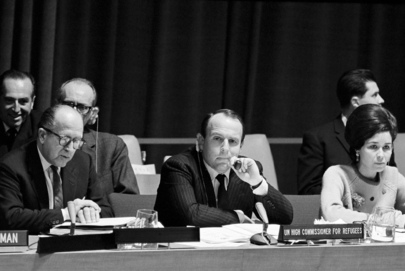
Constantin A. Stavropoulos, UN Legal Counsel, addressing a Committee at the United Nations in New York on 06 December 1966 on the Report of the High Commissioner for Refugees. At the table with him are Prince Sadruddin Aga Khan (centre) and Mrs. Halima Enbarek Warzazi (Morocco), Chairman of the Committee. Photo Credit: UN Photo
Courier: So you decided to do something about this problem yourself…
Prince Sadruddin: I have always been in favour of individual initiatives. I also take a very close interest in the environment, animals, plants, disappearing species….And so I set up the Bellerive Foundation, which takes its name from that of the Geneva commune where I live. It is a non Governmental organization (NGO) which finances a certain number of studies and activities in collaboration with international institutions, British and Scandinavian bilateral aid organizations, and other NGOs such as the World Wide Fund for Nature.
Initially we were very closely involved, along with UNICEF, the United Nations Children’s Fund, in the struggle against deforestation. But we wanted above all to be present in the field and to do things at the local level. Rural populations in the Third World suffer far less from the oil crisis than from a very serious firewood shortage. With the help of Swiss specialists we have developed cooking stoves which use very little fuel, and use renewable energy sources such as methane and biogas. We have used these stoves to equip communities, the armed forces, police stations, schools, bush hospitals and many rural African families. These low-priced stoves are today so highly appreciated that we can no longer satisfy the demand, notably in Kenya.
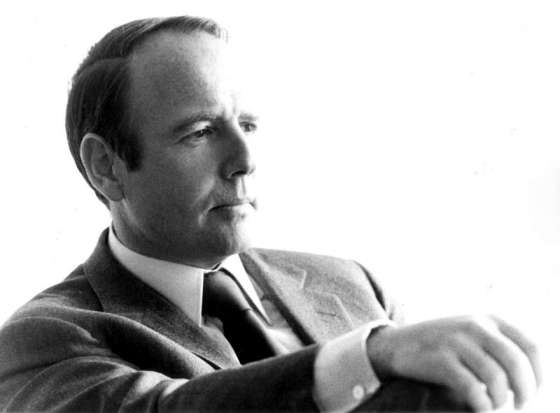
A portrait of the late Prince Sadruddin Aga Khan. UNHCR photo. Copyright.
Our programmes are extremely decentralized, we have regional offices. The main one is in Nairobi. Deforestation has wreaked havoc in Kenya, whose demographic growth rate is one of the highest in the world. The population doubles every seventeen years!
We are also interested in the risks from nuclear energy. We are a many-sided group whose members include scientists, churchmen, university teachers and senior international civil servants. We organize conferences and inform the public about the possible different options in this field. We are also helping to strengthen the Treaty on the Nonproliferation of Nuclear Weapons. Finally, we are helping to defend certain threatened species such as the elephant, which has almost been exterminated by ivory poaching.
Let us show great humility towards the peoples we wish to help, for we have very little to teach them.
Courier: Is collaboration increasing between the institutions ofthe United Nations system and non-governmental organizations, which are more flexible and closer to people?
Prince Sadruddin: Certainly. I noted this in Afghanistan, for example, at a time when the UN could not enter the country and when a number of NGOs managed to operate there.
I have worked hard to bring together NGOs and UN agencies, and I am happy to see my efforts bearing fruit. Of course there are still certain suspicions. The NGOs fear the bureaucratic weight and political pressures to which international organizations may be subjected. The international organizations, for their part, fear the sometimes anti governmental inclinations of the NGOs.
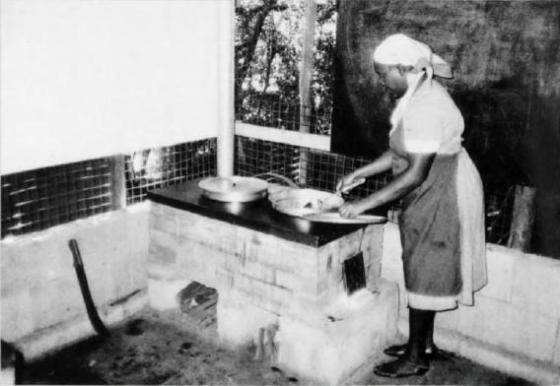
At the Bellerive Foundation’s centre In Nairobi (Kenya), meals are prepared on the low-fuel stoves which the Foundation distributes in Africa. Photo Credit: The UNESCO Courier. Copyright.
Courier: Can any lesson be learned at this stage from the co-operation between intergovernmental institutions and NGOs?
Prince Sadruddin: When major infrastructure work such as airport, dam or road construction is not involved, the approach of the NGOs, which intervene at grassroots level, is certainly preferable in development projects.
The success of any development project is based on encouraging people to shoulder their own responsibilities and become aware of their own capacities, their rights too, rather than providing them with ready-made solutions. Who knows better than a peasant farmer the agricultural conditions in his country or region? It is not always necessary to send an FAO expert to tell him what crops to grow or what seeds to use. Give him the seeds he asks for, and he will do the rest. Don’t tell him how to renovate his irrigation system: give him the necessary equipment and he will do the job far better than us. He will know how to make use of local raw materials. The international expert will turn up with plastic piping and reinforced concrete in a situation where it is better to use beaten earth. As if one could ask UNESCO experts to teach Afghans how to weave carpets!
Let us show great humility towards the peoples we wish to help, for we have very little to teach them. I think we go wrong when we insist, as some have done since 1945, on using experts who are paid Western salaries, drive beautiful cars and live in air-conditioned houses to teach people in the Third World how to improve their living conditions.
Courier: So what is the point of international aid?
Prince Sadruddin: It helps the experts themselves! Multilateral aid should be continued all the same, for it is impossible to remain unaffected by extreme poverty. But to be effective, this aid should enable the victims of poverty to achieve a certain form of self-sufficiency, however modest. It is better to concentrate on less ambitious projects in rural areas than to pursue, for example, the mindless policy of industrializing at all costs in countries where such a course is impossible, in order to obtain currency with which to buy imported mineral water and Camembert!
Those responsible should be induced to change their approach. There should be a kind of peaceful revolution. Here I think that we are starting to learn the lessons from natural catastrophes provoked by man, such as deforestation and drought. Of course the pessimists will say that in any case the planet is ruined, but there are also optimists who believe that it is still possible to influence the course of events.
© Copyright UNESCO. All rights reserved
Date article posted on Simerg: November 27, 2010
Last updated: November 28, 2010
~~~~~~~~~~~~~~
Please also click:
Please visit the Simerg Home page for links to articles posted most recently. For links to articles posted on this Web site since its launch in March 2009, please click Table of Contents.
Sign-up for blog subscription at top right of this page.

In response to Vali Jamal’s mentioning ‘Pyarali’ the African ismaili in Kampala where I was born, went through school on to Makerere University leaving for University of Oxford before the Uganda crisis of 1972. Pyarali became an Ismaili thanks to Habib Ratansi family (later known as ‘Virani’ with late Badrudin Virani who served in the Aga Khan Education Board while I was an upper primary teacher). They lived a few doors away from our house in William Street opposite Sarwajanik Dawakhana. As a child I saw him in Jamatkhana almost everyday and he had picked up Kutchhi and Gujarati that our people spoke. Everyone in the Jamatkhana knew and respected him, I can actually picture his face with his front teeth not in good shape or form. He knew how to win hearts of children and adults and was very much trusted with minor errands and service to others and in the running of tasks during Jamatkhana sessions.
I am so glad he was able to leave Uganda in spite of being of African origin. Vali has filled me up about this exemplary ‘murid’ since I left Kampala in 1967.
Great article related to the honorable uncle of our beloved Hazar Imam, Mawlana Shah Karim al-Hussaini. Thank you, Simerg, for your Web site and great efforts in bringing this precious interview to our attention.
Dr. Karim
What a heart-warming story! Prince Sadruddin figures in my book about Uganda Asians for his role in rescuing the last of the people of “undefined nationality” from Uganda in 1972. The Canadians had taken away 6,292 persons. Around 4,000 with verified Uganda passports thought they would make a go of their citizenship. Idi Amin scared the daylight out of them by threatening to rusticate them to camps in Karamoja. They just threw their passports away and presented themselves at the UNDP. They were taken to UNHCR camps in 4-5 European countries. The Prince visited the camps.
At Rome he sighted an African face. Prince: “What are you doing here?” African: “Why, I am Ismaili.” Everyone knows him – Marhum Pyarali “Momin.” I am going to include a page of tribute to Marhum Pyarali as The African Who Came Through. If any readers have stories about him or about ending up at UNHCR camps they’d be most welcome. In my book I have 5 pages on the internal discussions at the UNHCR concerning the Ugandan Asian refugees.
In the history of the world during the last century, Prince Sadruddin Aga Khan was the most compassionate and wise leader of the Muslim world. His great wisdom and love towards suffering humanity earned respect for Muslims of the world and Islam on the whole.
I have met Prince Sadruddin Aga Khan on a few occasions and have admired his humility and candour. His efforts for the refugees, especially of the African Asian areas, give us much to think about. The demographics of the AfroAsians are quite different to those of Eastern Europe, and every effort must be made to ensure development of the AfroAsian areas themselves to provide gainful employment of their own peoples. Micro and later intermediate level financing to cluster groups would be one way.
Congratulations to Simerg for presenting this information to the readers. We have read about Prince Sadrudin Aga Khan in parts through various sources but I do not recall a fine comprehensive account. Well done!
I am glad to read (and see some pictures of) all the great contributions of Prince Sadruddin Aga Khan. I am proud of his good work performed during his lifetime and the legacy that he has left behind for us to cherish his work.
What a fabulous article. Nature is something that brings me personally, a lot of peace and is filled with metaphor. I did not know all this about Prince Sadruddin, although I had also been fortunate in my not so “toto days” to view and decorate my space with some of the art of his NY collection.
How gentle and visionary a man; as has been, the visionary nature of the Aga Khan family; and then the attention to detail for growth and opportunity of families, and communities. In fact, we see this in all of Mawlana Hazar Imam’s work, something we should think about in our own lives and pray for that inspiration: self sufficiency, intelligent interaction with our environments, sustainability of our endeavors, and a sense of the brotherhood of man. Thank you Simerg for bringing this superb interview to our attention and thought